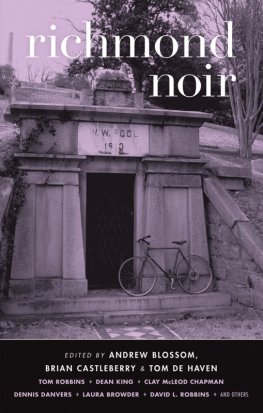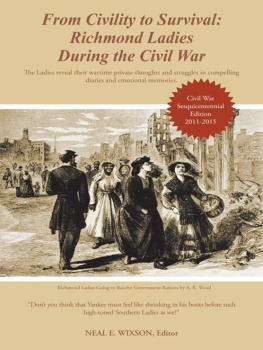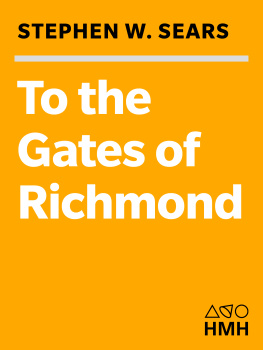

Published by The History Press
Charleston, SC 29403
www.historypress.net
Copyright 2007 by Harry Kollatz Jr.
All rights reserved
Front cover image: Around 1868, civil engineer Charles Henry Dimmock designed the Hollywood Cemetery pyramid. Perhaps it looked easy enough on paper, but finishing it with granite stones was another matter. Courtesy of the Valentine Richmond History Center.
First published 2007
Second printing 2008
Third printing 2009
e-book edition 2013
ISBN 978.1.62584.401.9
Library of Congress Cataloging-in-Publication Data
Kollatz, Harry.
True Richmond stories : historic tales from Virginias capital / Harry Kollatz, Jr.
p. cm.
Articles which originally appeared in a local history column in Richmond magazine.
print edition ISBN 978-1-59629-268-0 (alk. paper)
1. Richmond (Va.)--History. 2. Richmond (Va.)--Biography. 3. Richmond (Va.)--Anecdotes. I. Title.
F234.R557K65 2007
975.523--dc22
2007021395
Notice: The information in this book is true and complete to the best of our knowledge. It is offered without guarantee on the part of the author or The History Press. The author and The History Press disclaim all liability in connection with the use of this book.
All rights reserved. No part of this book may be reproduced or transmitted in any form whatsoever without prior written permission from the publisher except in the case of brief quotations embodied in critical articles and reviews.
For Amie O., My Grande Louvre,
who married me, Richmond and the
Firehouse Theatre Project, and has
somehow maintained her love for all
three. All within is the past, but
we are just beginning.
and
For Ed, Lorena and Sharon: who knew that
Edsels would get us this far?
I would rather die in Richmond somehow, though God knows Richmond has little enough to offer. But in Richmond, or in any Southern city for that matter, you do see types now and then which depart from the norm. The South is full of eccentric characters, it still fosters individuality.
Henry Miller, The Air-Conditioned Nightmare (1939)
Contents
Foreword
Observant Richmonders, if they know what they are looking for, will often spy loping along West Broad near the Science Museum or through one of those pleasantly bosky streets of the Fan a tall figure wearing one of those hats I believe were, in their day, known as fedoras. The man walks with a purpose, but it cannot be said that he is lost in thought. He seems to know something interesting about most houses he passes and surely each statue. To walk with him, for he is a talkative fellow, is an education in his citys present and past. A little of what he knows makes it into the Flashback column he writes for Richmond Magazine, but there is a lot that does not. One hopes he finds room for it in columns to come.
This somewhat enigmatic, even romantic figure, is Harry Kollatz Jr., who may be more of a treasure than his engagingly rambling column, though it is nothing to sneeze at, either. Kollatz is not only a writer and historian. He is also an actor, a director and an impresario, as well as a pretty fair raconteur. To read one of his columns is to know what it is to go on long walks with him when, coming upon some abandoned warehouse, he stops to tell you what went on there in, oh, 1913. He knows what occurred in grand old houses on Monument Avenue but also on empty lots in Oregon Hill. How he knows these things is anybodys guess, but I am glad he does.
The column is chockablock with oddments and served up, thankfully, without the snarky Weird America facetiousness that afflicts so much journalistic writing these days. Kollatz is not solemn, and he does not lack a sense of humor and even a sense of the absurd. But he treats his subjects, no matter how outlandish, with respect. He can also write well about serious matters, as he does in his essay, printed herein, about the actor Charles Sidney Gilpin.
My personal favoriteand one that seems somehow representative of the wholeconcerns Lady Wonder, the Chesterfield County horse of the 1920s. For fifty cents, Lady Wonder would answer questions on a device Harry describes as a piano-size, scrap-metal typewriter mounted on two rusty jacks that used a double row of keys topped by sponge rubber. When Lady nudged a key with her nose, a bracket was released, and a tin card popped up bearing a letter or number.
Lady Wonder predicted the outcome of ballgames and elections, advised the lovelorn and helped baffled police detectives solve cases. A Duke University psychologist came up from Raleigh to investigate the horses alleged powers and determined that she could spell such words as Mesopotamia and Hindustan, a feat which would make her a marvel not only among horses but also among most American high school students, Standards of Learning or no.
I do not wish to make too much of the connection, but Harry Kollatz is something of a phenomenon as well, and you will enjoy the reportage that follows. I know I did. We know what happened to Lady Wonder (she died, Harry says, on March 19, 1957), but we do not know what happened to the contraption on which she composed her answers. I like to think Harry keeps it in his attic and used it to write these columns. If so, it might explain Harrys own remarkable gifts. Enjoy!
Alan Pell Crawford
Author
Preface
The Flashback column premiered in 1993 as a small rear-guard defense against encroaching oblivion. One of the frustrations in writing about the citys history is that the present and its often short-sighted demands are eating away at the vital past.
Most times, magazine columns arent enough. Such was the case in September 1995, when the Capitol Theater, at 2525 West Broad Street, was with almost cruel zeal (and little cause) ripped to pieces. The Fan District and West Grace Street Associations tried halting the sudden demolition because the apparent intention was to install a McDonalds with a drive-through window on the busy corner of Robinson and Broad. The neighborhood groups chased Mickey Ds down the street, but it couldnt forestall the Capitols destruction. When I got to write about it in December 1995, it was as if the place never existed. The lot, to this day, remains scruffy grass that collects wind-blown trash.
The Capitol Theater was built in 1926. Richmond Italian American sculptor and plaster artist Feruccio Legnaioli created the Richmond regions first atmospheric theater dcor. The auditorium simulated a Spanish garden, complete with draping greenery, urns, iron gates and statue niches. This interior didnt survive successive remuddlings during the 1930s and 1960s. The Capitol was the first in the South and the sixth in the nation to possess Movietone synchronized sound equipment. The Jazz Singer, the first talkie, premiered in Virginia at the Capitol. A generation later Richmond movie impresario Ray Bentley started all-night movie jams there. People saw for the first time at the Capitol M*A*S*H, The Exorcist, Lenny and Silver Streak.
The theater anchored a block of diversion across from the bustling Broad Street Station; the row included the Byrd Hotel and Julians Restaurant. Broad Street Station closed, ending the usefulness of the nearby William Byrd Hotel and reducing the patronage of next-door Julians Restaurant. The property owner wanted to cobble these properties into a convention center, but that scheme fell through. The Byrd became a retirement center, Julians moved up the street (and then away) and the Capitol was leveled. I took pictures.








